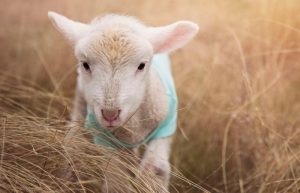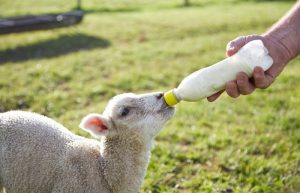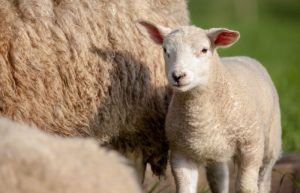
What Do You Call a Baby Sheep?
Not only are sheep a low-maintenance small livestock option but their cute and cuddly gentle appearance makes them popular as backyard and barnyard pets. Sheep can be used for many different things, from growing wool and maintaining land to being sold for meat and used for breeding. If you’re looking for some friendly pets or a profitable farm venture, sheep may be the way to go.
So, what do you call a baby sheep? A baby sheep is called a lamb. Sheep are considered lambs until 1 year of age. If the baby sheep is a female, it will be called a ewe lamb. If the baby sheep is an intact male, it will be called a ram lamb.
Young livestock requires specific care to ensure that they grow and develop properly. If you plan on raising lambs, it’s important to know how to maintain their health and raise them to be productive sheep. Keeping reading to learn all about raising lambs!
What You Need to Know About Baby Sheep
There is much to know about lambs, their characteristics, and their health requirements. While sheep are low-maintenance animals, it’s always a good idea to monitor lambs and their progress. Here are some essential lamb facts to know:
When Are Baby Sheep Born?
A female sheep’s gestation period is 145 – 150 days; then they will give birth to their offspring in a process called lambing. A ewe, or female sheep, has an estrus cycle every 16-17 days, so they could technically become pregnant at any point of the year. However, farmers will usually breed their sheep in October or November so that the lambs can be born in the Springtime. This puts less stress on the mothers compared to giving birth in the winter or summer months when there are extreme temperatures to deal with.
How Much Food Do Lambs Need?
At the beginning of their lives, lambs will rely solely on their mother’s milk for all the nutrients and vitamins they need. Even within the first 30 – 60 minutes of being born, a lamb will usually be nursing. It is vital for the lamb to nurse its mother within the first 24 hours of its life so it can get vital antibodies and vitamins that will benefit the lamb’s health.
While lambs will start nibbling on grass, grain, or hay a few days after birth, they will stay reliant on milk for about 3 – 4 weeks after birth. In this timeframe, lambs usually require 20% of their body weight in milk a day. Whether they naturally nurse from their mother or if you bottle-feed them milk replacer, your lamb will drink as much as 30 – 40 ounces of milk per day.
The total amount of milk your lamb will need should be split up into feeding times for your lambs. Newborn lambs need to eat every 2-3 hours while lambs a few weeks old can start being fed in 4-hour increments.
When Do You Wean Baby Sheep?
At a certain point in your lamb’s development, you will need to wean them from their mother. Weaning is when you separate the lamb and the dam so that the lamb can learn to be independent of its mother. This will help the lamb to accept a diet of forage rather than milk. It will also give the ewe time to rest before the next breeding season.
Lambs are usually weaned between 3 – 4 months old. Lambs start nibbling on real food at just a few days old, and as they age, forage will become more incorporated into their diets. The dam’s milk production will peak when the lamb is about 4 weeks old, meaning that the ewe will produce less and less milk going forward.
When Do Lambs Reach Maturity?
A baby sheep is officially a lamb until they turn 1 year old; however, most sheep reach maturity before that point. The age of maturity is different for male and female sheep. A ram lamb can reach maturity as early as 4 – 6 months old, while ewe lambs usually reach maturity between 6 – 8 months. That being said, you should wait until your sheep are one year of age before breeding them to ensure proper development and physical health.
Why Do You Bottle Feed Baby Sheep?
If you ever went to a petting zoo on a school field trip as a kid, you were probably given the opportunity to bottle feed lambs. It may seem like you hear of people bottle feeding lambs more than you hear about the lambs nursing from their mothers. You will need to bottle feed lambs if they have been orphaned, if their mother is sick, if they are refusing to nurse, or if their mother has neglected them.
What Do You Bottle Feed Lambs?
 Within the first 24 hours of a lamb’s life, lambs require colostrum, which is the milk produced by a ewe during the first hours after birth that provides essential antibodies and vitamins that will help the lamb to fight off diseases and build its immune system. Without it, the lamb will be in danger of a weakened immune system.
Within the first 24 hours of a lamb’s life, lambs require colostrum, which is the milk produced by a ewe during the first hours after birth that provides essential antibodies and vitamins that will help the lamb to fight off diseases and build its immune system. Without it, the lamb will be in danger of a weakened immune system.
If the lamb cannot nurse its mother for some reason, you will need to bottle feed it colostrum, either by milking the dam or by taking milk from another sheep that has just given birth. If all else fails, you can use colostrum powder to mix into a liquid form for the lamb to consume.
After the first 24 hours, you can start feeding the milk replacer to the lamb. Milk replacer usually comes in a powder form to be mixed with water. While you should mix the replacer with warm water, it’s important that you give the solution to the lamb cold, as it’s easier for them to digest.
How Often Do You Have to Bottle Feed Baby Sheep?
Lambs have to feed frequently throughout the day to get the proper nutrition and proteins they need to develop and stay healthy. In the first few weeks of life, lambs will need to be fed at least 4 times a day. After a few weeks, you can cut the lamb down to 3 times a day.
If your lamb isn’t getting enough food, or if they aren’t eating frequently enough, they may excessively bleat and call. It’s important to watch for this behavior so that you can adjust feeding times for the lamb. To learn more reasons why your lamb my bleat, check out my article Why Sheep Bleat: Essential Behavior Guide.
When Can You Stop Bottle-Feeding Lambs?
To determine when to stop bottle feeding a lamb, you’ll need to watch how well the lamb is consuming dry food and if they are regularly grazing. You can usually stop bottle-feeding lambs when they are 30 – 45 days old. if the lamb was nursing naturally, this is when the mother would hit peak milk production and then start producing less and less from there.
When Do You Castrate Baby Sheep?
An important aspect of herd management is required when dealing with baby lambs, which is castrating the male lambs. If you plan on castrating the ram lambs in your sheep flock, it should be done when the lambs are 1 – 7 days old. At this young age, the lambs can be more pain tolerant. You also want to avoid castrating male sheep after they have reached maturity, or they still may have some ram tendencies, like aggression and dominance.
What is a Wether Sheep?
Castrated male sheep are called wethers. Wethers are usually smaller than rams but also more docile and gentle since they produce lower levels of testosterone. In sheep breeds where only the males produce horns, wethers usually won’t produce horns, since testosterone production plays a role in horn growth.
Reasons to Castrate Male Sheep:
There can be many benefits to castrating male lambs before they reach maturity. While rams are essential to sheep breeding operations, they can also be difficult to handle, destructive, and aggressive. One reason to castrate your sheep is so that they will be easier to handle and nicer to other animals. Wether sheep can also live with ewes, which can help you save land and resources. Keeping rams will mean that you must use other pasture so you can keep the ram and ewes separate.
Wether sheep can also be raised to produce wool, to show, or to be used for meat. Although they may not be as big as rams, they can still be profitable to your operation. Wethers also make great companion animals and can be put in to keep rams company.
To learn more about wether sheep, check out my article Wether Sheep: Definition of Wether Sheep & Unique Traits.
Do You Have to Dock a Lamb’s Tail?
Tail docking is when you remove the lamb’s tail. While you don’t have to dock a lamb’s tail, there are some hygienic reasons for doing so. Here’s what you need to know about tail docking:
Does Every Sheep Need Its Tail Docked?
 Not every sheep needs its tail docked. The only sheep that usually get their tails docked are wool sheep. Wool sheep grow thick wool fleece throughout the year and they have long woolly tails. Hair sheep, sheep that grow a coat of hair rather than wool, don’t need their tails docked. With a manageable coat and shorter tail, there isn’t really a reason to dock their tails.
Not every sheep needs its tail docked. The only sheep that usually get their tails docked are wool sheep. Wool sheep grow thick wool fleece throughout the year and they have long woolly tails. Hair sheep, sheep that grow a coat of hair rather than wool, don’t need their tails docked. With a manageable coat and shorter tail, there isn’t really a reason to dock their tails.
Why Do You Dock a Lamb’s Tail?
The reason wool sheep need their tails docked is to keep feces from getting caught in their wool fleece. This can lead to hygienic issues and negative health conditions in the sheep. Since sheep live outside in different elements and conditions, they are susceptible to whatever nature has to offer. it’s important to maintain hygiene to avoid infections, parasites, and illnesses.
Another common reason farmers dock their sheep’s tails is so that they can monitor the health of the female sheep’s udders and genital area. If there is a problem in these areas, it can affect the sheep’s pregnancy, delivery, and their ability to care for their lambs.
When Should You Dock a Lamb’s Tail?
A lamb’s tail should be docked before they turn 12 weeks old. If you wait to dock the tail until a later time, it can be more painful for the sheep since the tail is more developed. Tail docking is usually done either by applying a tight rubber band to the tail or by cutting the tail with a sharp hot knife. Either way, it’s important that the person who is docking the tail has experience so that the procedure is done correctly.
Sheep Terminology You Should Know
Buck: an unofficial term to describe an intact male sheep
Dam: a female sheep that has given birth to a lamb; this term is used to describe the ewe as a mother
Ewe: an adult female sheep capable of reproducing
Fleece: the thick wool coat grown by wool sheep
Flock: a group of usually more than five sheep; a community of sheep that provides security and protection from predators and other threats
Hair Sheep: sheep that have a coat of hair rather than wool fleece
Lamb: sheep that are younger than one year of age; can also be used to describe the meat produced by sheep younger than one year of age.
Mutton: meat produced by a sheep over one year of age
Ram: an intact adult male sheep capable of reproducing
Ram Lamb: an intact male lamb younger than one year of age
Shear: the act of removing a sheep’s wool fleece. This is usually done once a year in the Springtime to harvest the wool and to maintain the sheep’s hygiene..
Sire: a male sheep that has produced lambs; this term is used to describe the ram as a father
Wether: a castrated male sheep
Wool: a thick waterproof coat grown by certain sheep breeds. Wool can be harvested and turned into yarn and clothing products.
Wool Sheep: sheep that grow wool fleece
Yearling: a sheep between one to two years of age
Lambs may be cute and cuddly, but they still require effective care to ensure that they develop properly. We have many articles dedicated to the care of sheep. If you’re looking for more reading material, check out the articles below!
